Pieter de Hooch
- baptized December, 162–died March 24, 1684
- active in Delft c. 1653–c. 1663
Pieter de Hooch (also spelled "Hoogh" or "Hooghe") was born in Rotterdam to Hendrick Hendricksz de Hooch, a bricklayer, and Annetge Pieters, a midwife. He studied in Haarlem under the landscape painter Nicolaes Berchem (1620–1683), whose classical ruins and pastoral imagery seemed to have had a negligible impact on the artist. Documents indicate that in 1650 he was working as a painter and servant for a linen-merchant and art collector named Justus de la Grange. In 1654, he married Jannetje van der Burch, a woman from Delft, with whom he fathered seven children. He became a member of the Delft Guild of Saint Luke in 1655, moving to Amsterdam by 1661.
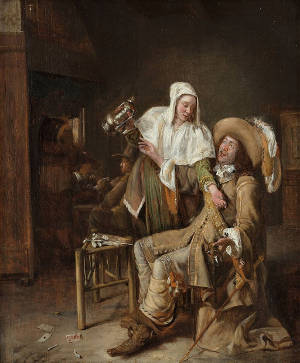
Pieter de Hooch
c. 1652
Oil on panel, 46 x37 cm.
Museum Boijmans Van Beuningen, Rotterdam
De Hooch began his career painting scenes called koortegardje (a corruption of the French phrase corps de garde) which picture rowdy soldiers in stables (fig. 1) or taverns in a scale of dark browns and yellows. In Delft, he focused on gezelschappen, or merry companies, and portraits but specialized in middle-class interiors and courtyards where common folk go serenely about their humble duties.
Best known for his complex interior spaces and sun-drenched courtyards, De Hooch's command of perspective and responsiveness to light was unprecedented. His works, generally small, exhibit an exceptionally refined observation of the unnoticed details of everyday living. His sophisticated treatment of light is comparable, if not superior in certain instances, to that of Vermeer. However, his figures, except for those in the best works of the Delft period, although they appear angular, resembling wooden puppets, yet are never displeasing. On the other hand, their seeming clumsiness is a large part of the unpretentious charm of the scenes. De Hooch's technique, while functional, may not reach the technical heights the most technically sophisticated painters of the School of Delft, to say nothing of the Leiden fijnschilders (fine painters) who brought oil painting technique to its apogee.
De Hooch's brush handling is often less than elegant, yet his mode of description is evocative.Whatever intellectual lacunae or technical insufficiencies the grouping of figures in de Hooch's interiors might betray, by comparison, Vermeer's compositions appear staged. It is precisely this quality that has drawn so much attention to Vermeer in the twentieth century.
Domestic imagery constituted about one-third of de Hooch's output. Although deeply intimate in character, his depictions of domestic life are free of the sometimes mawkish sentimentality and overly-obtrusive anecdote which were hallmarks of Dutch genre painting. His narratives are generally straightforward, certainly more so than Vermeer's, and show scarce interest in moralizing innuendos or iconographic subtleties. Although he may occasionally use pictures-within-pictures to add supplementary comment to the principal subject "atter, "the meaning of his art is usually directly associated with the subjects depicted, rather than through covertly coded ideas."Jane Turner, From Rembrandt to Vermeer: 17th-century Dutch Artists (New York: St. Martin's, 2000), 166. Few of his colleagues were able to capture the everyday thoughts of their painted figures, admittedly, extraordinarily difficult to pin down in the medium of painting. Vermeer was an exception. Women and children, almost to the exclusion of husbands and fathers, are repeatedly represented in simple situations in the home.Peter C. Sutton, Pieter De Hoogh: Complete Edition (Oxford: Yale University Press and Wadsworth Atheneum, 1980), 45. He was particularly sensitive to the relationship between mothers and daughters.
De Hooch and Vermeer
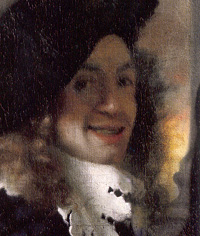
Johannes Vermeer
1656
Oil on canvas, 143 x 130 cm.
Gemäldegalerie Alte Meister, Dresden
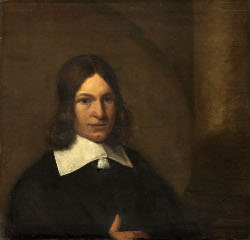
Pieter de Hooch
1649
Oil on panel, 32.5 x 34 cm.
Rijksmuseum, Amsterdam
The relationship between Vermeer (fig. 2) and De Hooch (fig. 3) has been the source of considerable debate among art historians. Nineteenth-century art historians had assumed that de Hooch had been influenced by Vermeer's work, but the opposite is now believed to be the case. Vermeer's early works of the 1650s reveal little interest in the developments that were revolutionizing Dutch genre painting. It was not until 1657 that he painted his first known genre interior, A Maid Asleep, in which he made a "superficial adaption" of the innovative motifs developed in Delft. "But nothing in this painting leads us to suspect that its author would eventually develop a perfect synthesis of illusionism and 'classical' composition. It was an external impulse—the work of Pieter de Hooch—which stimulated Vermeer's attempt at this synthesis."Albert Blankert, Vermeer of Delft (Oxford: Phaidon, 1978), 29.However, given the paucity of historical evidence, it is not out of the question that Vermeer led the way on some occasions, while on others, De Hooch did, even though his earliest works (fig. 3) show nothing particularly original. Whatever the case may be, although the art of de Hooch may appear today as wanting in intellectual profundity and philosophical implications (and perhaps ambition) when compared to the art of Vermeer, de Hooch was unquestionably the more prolific and versatile painter of the two.
De Hooch explored a number of different lighting schemes (fig. 4) other than the traditional left-to-right raking light which Vermeer never abandoned except in two late works, The Lacemaker and The Guitar Player. Unlike his contemporaries, De Hooch also employed backlighting not only in his outdoor scenes but in his interiors as well. Particularly admirable is his ability to register, with the utmost fidelity, the reflections of light on ceramic pots, polished wood and glass. His renderings of dimly lit interiors struck by a shaft of light penetrating from a window or open door have no equal.
While stylistic contrivances in Vermeer's paintings can be plausibly linked to the image produced by the camera obscura, nothing in de Hooch's work shows he was dependent on, or even interested in, any sort of optical device.
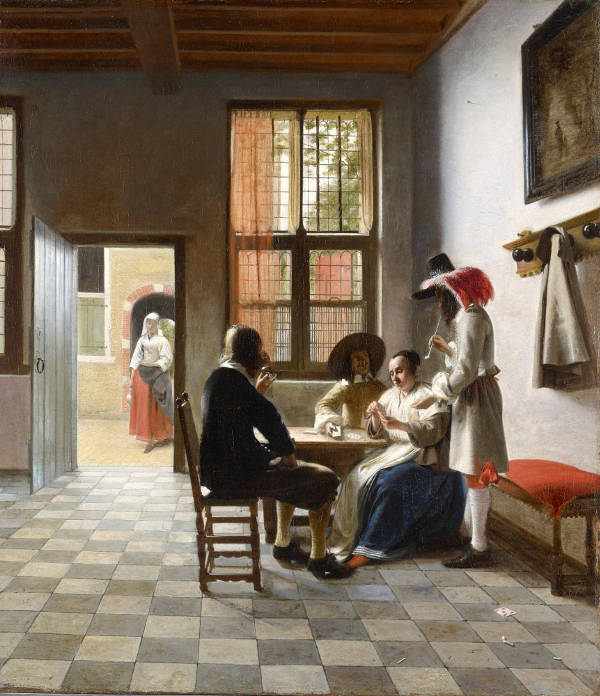
Pieter de Hooch
Oil on canvas, 77.3 x 67.3 cm.
The Royal Collection, London
The Domestic Courtyard Scene
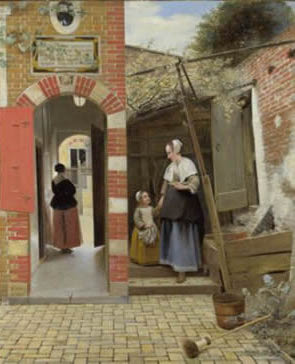
Pieter de Hooch
1658
Oil on canvas, 73.5 x 60 cm.
National Gallery, London
De Hooch is credited with almost single-handedly inventing one of the most popular motifs in genre painting while in Delft: scenes of private, urban courtyards (fig. 5).
"Courtyards were an intrinsic feature of Dutch domestic architecture, and were either constructed within the middle of a house or at its very back. Houses in Dutch cities were customarily built close together on long, narrow lots. One function of the courtyard was to provide light to their interiors. Despite de Hooch's habit of including instantly identifiable structure in the background, his pictures do not simply duplicate real courtyards in paint. Thus, the artist's representations of courtyards, like his interior scenes, were, ultimately, contrived, skillfully combining direct observation of his immediate surroundings with prevalent pictorial conventions."Wayne Franits, Pieter de Hooch: A Woman Preparing Bread and Butter for a Boy, Getty Museum Studies on Art (Los Angeles: J. Paul Getty Museum, 2006), 16. His domestic scenes had an important influence on the development of the motif.
Although de Hooch excelled in a number of motifs, his specialty was the so-called doorkijkje, or "see-through door" motif, which reveals secondary and tertiary views into other rooms, courtyards or the street beyond (fig. 6). This apparently simple device offers the painter an opportunity to create a more complicated architectural space and simultaneously expand narrative. The art historian Martha Hollander found that among more than 160 paintings attributed to de Hooch, only twelve do not exhibit this device.Martha Hollander, An Entrance for the Eyes: Space and Meaning in Seventeenth-Century Dutch Art (Berkeley, CA: University of California Press, 2002), 153.
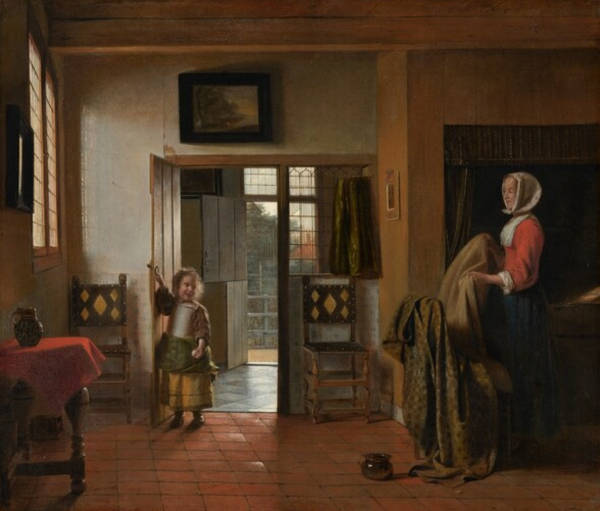
Pieter de Hooch
1658/1660
Oil on canvas, 51 x 60 cm.
National Gallery of Art, Washington D. C.
The light, perspective and descriptive detail of de Hooch's mature works are often so believable that they appear to be faithful records of actual sites. They are, however, significantly a product of the painter's imagination and compositional skill. "Glimpses of Delft monuments, including the Oude Kerk, the Nieuwe Kerk, the Town Hall and the Old Town Wall, regularly appear in his outdoor scenes. Yet the recurrence of altered and relocated details confirms that these paintings include fictitious assemblages of naturalistic motifs."Peter C. Sutton, Pieter De Hoogh: Complete Edition (Oxford: Yale University Press and Wadsworth Atheneum, 1980), 25.
While Vermeer had achieved a higher professional standing in his era than de Hooch, in the centuries that followed Vermeer's fame became gradually obscured. De Hooch's signature was added posthumously to various works by Vermeer in order to increase their monetary value, including the latter's masterwork, The Art of Painting.
After he left Delft, de Hooch began to paint for wealthier patrons in Amsterdam, although he lived in the poorest areas of the city. In Amsterdam, the quality of his work gradually deteriorated, a decline that may have been influenced by his wife's death in 1667. He died in 1684 in an Amsterdam insane asylum, though the circumstances of his admission are unknown.